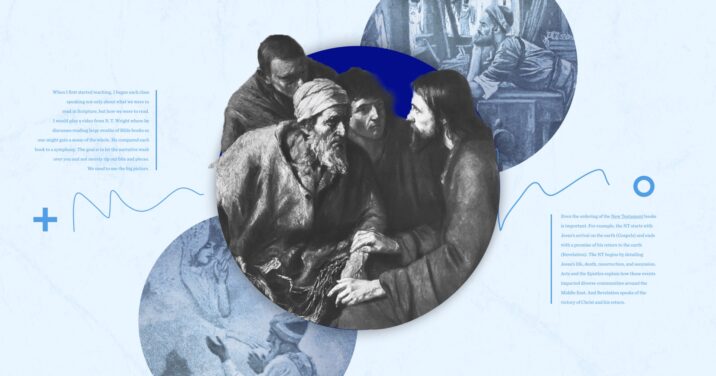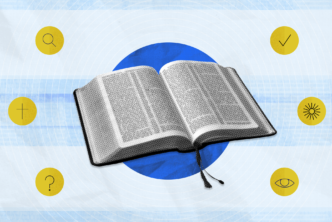When I first started teaching, I began each class speaking not only about what we were to read in Scripture, but how we were to read.
I would play a video from N. T. Wright where he discusses reading large swaths of Bible books so one might gain a sense of the whole. He compared each book to a symphony. The goal is to let the narrative wash over you and not merely rip out bits and pieces. We need to see the big picture.
This is true not only for individual books of the Bible but for both the New Testament and Old Testament as a whole. They also are symphonies, with low and high notes, bigger and smaller stories, and certain climactic events. Some might be hesitant to read entire Testaments together. Each includes different authors who write at different times to different audiences. Yet the Bible is one story because it has one divine author who brings all the disparate pieces into cohesion.
Even the ordering of the New Testament books is important. For example, the NT starts with Jesus’s arrival on the earth (Gospels) and ends with a promise of his return to the earth (Revelation). The NT begins by detailing Jesus’s life, death, resurrection, and ascension. Acts and the Epistles explain how these events impacted diverse communities around the Middle East. And Revelation speaks of the victory of Christ and his return.
Three New Testament themes
While there are many ways I could describe the big picture of the New Testament, a few core elements are found in each New Testament book, and all of them fall under the banner of “fulfillment.” In the Old Testament, promises were made; in the New Testament, promises are kept. The OT is the story of the old covenant; the NT is the story of the new. Three themes in particular speak to the unity of this story.
Messiah
First, and maybe most importantly, the New Testament is built on the conviction that Jesus is the Messiah. He is the long‐awaited King, Savior, and Davidic heir. He became King by his faithful life, sacrifice on the cross, victory of life in the resurrection, and exaltation in the ascension. Without this reality the New Testament would not exist. Without this reality no Christian faith would exist. Without this reality there would be no church. Every writer writes because they are convinced Jesus is the Messiah.
But there is even more. Jesus is declared to be more than the Messiah. He is God’s unique Son, the exact imprint of his nature. The New Testament reveals our Triune God. The Father sends the Son, the Son is generated from the Father, and the Spirit proceeds from the Father and Son. All three are at work in our salvation as the Father plans, the Son accomplishes, and the Spirit applies our redemption. So the New Testament is all about our Triune God seen in Jesus the Messiah.
The kingdom
Second, the New Testament concerns God’s kingdom. Jesus’s manifesto as the Messiah is that this kingdom is at hand in his very person. He announces the arrival of kingdom hopes, yet also the anticipation for them to be fully realized. The kingdom is the promise of God’s power and presence over his people in their appointed place.
While the mission of Jesus began the realization of these promises, we must wait for them to come to fruition. The goal of life is to see the face of God and be in his presence. Jesus came as the Messiah to bring his people home.
God’s people
Third, the New Testament concerns God’s people. When Jesus comes on the scene, his people are in exile. Things are not as they should be. But Jesus releases them, and God’s people are redefined. No longer are they identified primarily by their ethnicity; now they are welcomed by faith—and faith alone. Jesus welcomes all nations to himself and sends out his church to spread this message to every corner of the earth. No VIP cards are needed to enter his community, only faith and repentance.
Jesus. Kingdom. God’s people. That is what the New Testament is all about.
The Gospel
God reigns and saves through his Messiah in order to bring his people into the kingdom and be with God forever. The New Testament describes this message as “the gospel.”
This is how we read.
***
This article was originally published in the November/December 2021 issue of Bible Study Magazine. Slight adjustments, such as title and subheadings, may be the addition of an editor.
Related articles
- A Strategic Approach to Reading Background Texts of the New Testament
- How to Deal with Inspired Ambiguities in the New Testament
- Psalm 2: Its Meaning in the New Testament
Related resources
The Kingdom of God and the Glory of the Cross (Short Studies in Biblical Theology)
Regular price: $10.99
Mobile Ed: Craig A. Evans New Testament Backgrounds Bundle (6 courses)
Regular price: $599.99






